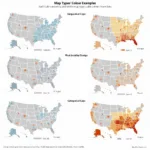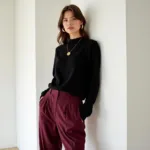When it comes to colors, red and green might be the most common pair we think of. They’re the colors of Christmas, the stop and go lights that guide our way, and even found in nature as strawberries and their leaves. But have you ever wondered, “What color does red and green make mixed together?” Let’s dive into the fascinating world of color mixing and uncover the answer!
Red + Green = Brown? Not Always!
You might have heard that mixing red and green creates brown, and you wouldn’t be entirely wrong. In the world of traditional paint, this is often the result. However, the exact shade of brown depends on the specific reds and greens you use, their ratios, and even the type of paint.
 Mixing Red and Green Paint
Mixing Red and Green Paint
But color is more complex than just paint! When we’re talking about light, which is how we perceive color on screens, red and green actually create yellow. This is because light mixes differently than pigments.
Understanding the Science Behind the Colors
To truly grasp why red and green sometimes make brown and sometimes yellow, we need to understand a bit about color theory.
Subtractive Color Mixing
Subtractive color mixing applies to physical mediums like paint, ink, or dyes. These substances absorb specific wavelengths of light, and what we see is the reflected light that’s left over. Since each pigment subtracts some wavelengths, mixing more colors together ultimately leads to darker shades, often culminating in brown or black.
Additive Color Mixing
Additive color mixing governs how we perceive light. It’s the principle behind screens, televisions, and stage lighting. In this case, we start with darkness and add different wavelengths of light to create color. Red, green, and blue are the primary colors of light, and when combined, they produce white light.
So, What About Red and Green?
- In paint: Mixing red and green paint will generally produce a shade of brown.
- In light: Red and green light, when combined, create yellow.
Think of your computer screen. By adjusting the intensity of red and green light, pixels can display a spectrum of colors, including yellow! This principle is also how we experience color on TV and in digital art.
The Role of Saturation and Value
Even within the realm of subtractive mixing, the brown you get from red and green can vary greatly.
- Saturation: Refers to the intensity or purity of a color. Highly saturated colors appear vibrant, while less saturated colors look duller. The saturation of your red and green paints will influence the resulting brown’s richness.
- Value: Describes the lightness or darkness of a color. Lighter values are closer to white, while darker values approach black. The value of your red and green will determine how light or dark the resulting brown appears.
For example, mixing a vibrant, saturated red with a dark, less saturated green might create a deep, chocolate brown. Conversely, mixing a pale pink (a less saturated red) with a bright, saturated green might result in a lighter, muddier brown.
Want to learn more about how colors interact? Check out our article on what is saturated color.
Beyond Brown: Exploring Red and Green in Design
While brown might be the expected outcome of mixing red and green, don’t let that limit your creative exploration! These colors can be combined in various ways to achieve stunning effects.
- Layering: Instead of mixing red and green directly, try layering them in a design. Think of a red flower against a lush green background—the colors remain distinct yet complement each other beautifully.
- Opposing Colors: Red and green are considered complementary colors, meaning they sit opposite each other on the color wheel. This contrast can create visually striking combinations that draw the eye. For a bolder look, consider what’s the opposite color of brown and see how it interacts with red and green.
- Accents and Details: Even small touches of red against a green background (or vice versa) can add depth and visual interest. For instance, a splash of red in a green room can energize the space without overwhelming it.
Conclusion
The next time you ponder, “What color does red and green make mixed together?” remember that the answer depends on your medium and creative goals. Embrace the versatility of these colors, experiment with different techniques, and let your artistic vision guide you!
FAQs
1. Can you make other colors by mixing red and green?
While brown (in paint) and yellow (in light) are the most common results, the exact shades can vary widely depending on the specific reds and greens used, their ratios, and factors like saturation and value.
2. Why are red and green associated with Christmas?
The association of red and green with Christmas has evolved over centuries, drawing from various cultural and religious traditions. Red symbolizes holly berries and Christ’s blood, while green represents evergreen trees, symbolizing life and rebirth.
3. How can I use red and green together in my home décor without it looking too Christmas-y?
Opt for shades of red and green that are less traditionally festive. For instance, try a deep burgundy paired with a sage green or a muted terracotta with a forest green.
4. Are there any cultural interpretations of red and green mixed together?
In some cultures, the color brown, often achieved by mixing red and green, is associated with nature, earthiness, and stability.
5. What are some other color combinations that create surprising results?
Mixing blue and yellow creates green, while blue and red produce purple. Explore the world of color mixing to discover more captivating combinations!
Need Help With Your Next Project?
Whether you’re looking to create the perfect shade of brown or want to explore the endless possibilities of color, we’re here to help. Contact us at Phone Number: 0373298888, Email: [email protected], or visit us at 86 Cầu Giấy, Hà Nội. Our team is available 24/7 to assist you with all your color needs!

